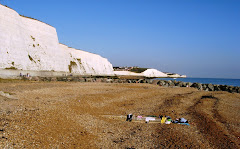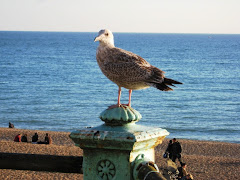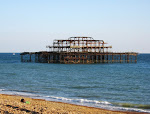

And so, well into the New Year and Christmas just a distant memory, thoughts turn to holidays and warmer days ahead, particularly when, like to-day, West London is doing its best to make up for last year’s below-average rainfall, seemingly in the last five minutes. This inevitably means travelling to somewhere warm, sunny and, possibly, exotic.
I think it was Robert Louis Stevenson who coined the phrase, ‘To travel hopefully is a better thing than to arrive’. Clearly, he must have had something more challenging than the 17.28 to Streatham Common in mind, but it makes you wonder about some of his relatives if the trials of mid 19th Century travelling – potholed roads and unheated carriages – were better than the destination. (Or maybe he’d Great Aunts like mine...)
Anyway, these days travelling is far more prosaic. Unless you go for something really exotic, like crossing the Sahara by motorbike or climbing Everest, you find yourself flying in and out of identikit airports, driving along tedious stretches of motorway, or taking Virgin Trains out of Euston, none of which stirs the blood in quite the way I suspect Stevenson had in mind.
Interestingly, though, train travel still manages to excite the imagination, and I’m not saying that just because I’m a bit geeky about it. Setting off from the refurbished St Pancras on a Eurostar is pretty cool, for a start. (Actually, the thought of racing through the British countryside at 186 mph is still hard to believe). But even more so are some of those great train journeys of the world that somehow have survived the competition from air travel.
There’s the Trans-Siberian, of course, either to Vladivostok or Beijing, which must still rank as the number one epic journey. (A word of advice – the Chinese trains don’t always possess no-smoking carriages, so unless you fancy secondarily smoking the equivalent of Navy Rough-Cut Extra-Tar, check you are in a no-smoking carriage. And take your own food).
But there are plenty of alternatives. Amtrak does some pretty cool long-distance trains in the USA, from coast to coast, as do Canadian railways. The Blue Train from Cape Town to Pretoria is South Africa is still one of the world’s most exclusive luxury trains. (Pub-quiz fact: classed as ‘International’, Blue Train passengers were not subject to apartheid restrictions).
But my best experience so far is the Indian – Pacific, from Perth to Sydney via Adelaide. Booked through those lovely people at Trailfinders in Kensington, this was a three day, 2,900 mile epic featuring mountains, outback towns, kangaroos, silver and gold mines, and desert. Huge great horizons of desert.
My other half thought I was mad, of course. “What? You’re paying more than four times the cost of a flight, for a three day journey you could fly in four hours?”. But that’s not the point. How else can you experience the vastness of this continent on a three week trip, and read a novel or two, all in one go? And acquire a natty complimentary wash-bag decorated with aboriginal art? (Which, I might add, I am still using).
So, one clear, warm April morning saw me at Perth’s East Station, finding my sleeping compartment in one of its fifteen carriages, before, with a suitable blast from the locomotive’s horn, we set off. After clearing the sprawling Perth suburbs, the train heads 400 miles east to Kalgoorlie, home to one of the largest open-cast gold mines on the planet. The trains stops here for an hour or two to load on cars and provisions, and on some runs they offer a night-time tour of the town by bus if you want it. It’s well worth it – the mine (300m deep, 1.5km wide and 4km long) is undeniably impressive, but not nearly as impressive as seeing the tarts waving to the bus in the red light district.
These ladies of the night service the thousands of miners in the town, who considerably outnumber the unmarried local female population. Our woman bus driver was very matter-of-fact and defensive of them: “We’re right proud of our girls here in Kalgoorlie Boulder. They’re kept real clean and Dr Davies gives them a health check every month. Without them, all our local girls would be up the duff.” And this all said in a voice betraying a 60-a-day habit of Navy Rough-Cut Extra Tar. Priceless.
After a dinner in the ‘Waltzing Matilda Dining Car’ - I kid you not – and a restful night’s sleep, comes dawn over the Nullarbor Plain. One of the hottest and driest places on the planet, and four times the size of Belgium, Nullarbor is bad Latin for ‘no trees’. The train makes a beeline straight across it – literally – including longest piece of dead-straight track in the world, all 297 miles (478km) of it. (Geeks, ahoy!). Crossing this vast expanse takes a whole day at 70 mph, an astonishing experience.
The train makes one short stop on the way, to refuel at the desolate and isolated railway town of Cook. Now almost a ghost town, it has a resident population of just four. This place regularly experiences temperatures of over 50C (now you know why Aussie beer is always served chilled). Believe me, you don’t want to be left behind.
After another few hours, you enter South Australia’s bushlands. Cue kangaroos (no-one tells you they are nocturnal, though, as you try to photograph them) and dusty outback towns, before settling into the wine country of South Australia and, after another night, its lovely, leafy capital, Adelaide.
The train then strikes north, towards the picturesque silver-mining town of Broken Hill, famously portrayed in the film ‘Priscilla, Queen of the Desert'. Depending on the schedule, you can take advantage of an hour or so to stroll into Broken Hill, and visit the famous ‘Mario’s Palace’ hotel with its murals, featured in ‘Priscilla’.
Another ‘Waltzing Matilda’ dinner, another night’s kip, and you awake to the spectacular scenery of the Blue Mountains, named after the blue-tinted mist caused by plant oils evaporating from the eucalyptus forest. (And it really is pale blue). A few hours later, and you arrive at journey's end at Sydney’s splendidly grand City Terminal, a suitably impressive gateway to this most iconic of cities.
Great stuff. Now, where are those travel brochures...?






